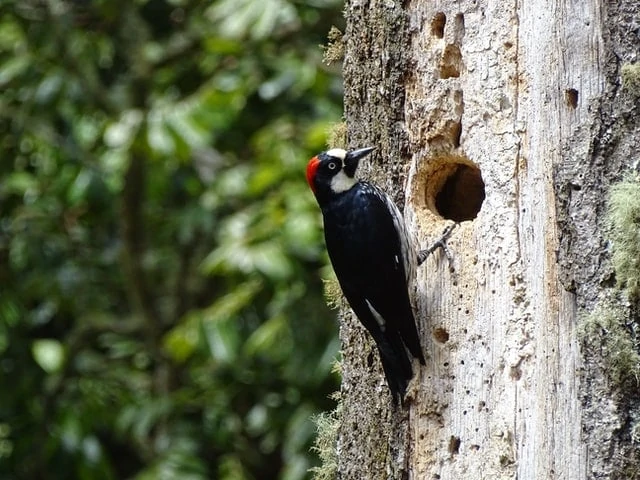Florida is home to over eleven woodpecker species, of which six stay around all year.
In this article:
We highlight nine types of woodpeckers in Florida. You'd understand the doubt soon enough. Anyways, about four of these birds will visit your backyard if you try to attract them with suet. If you’re something of an adventurer, then take hike trips to spot the evasive Florida woodpeckers in parks and wildlife centers.
Now, let's get to know these birdies better. See if you can answer the question at the end correctly.
This is gonna be fun! 🙂
The 9 Florida Woodpecker Species
1. Gold-Fronted Woodpecker
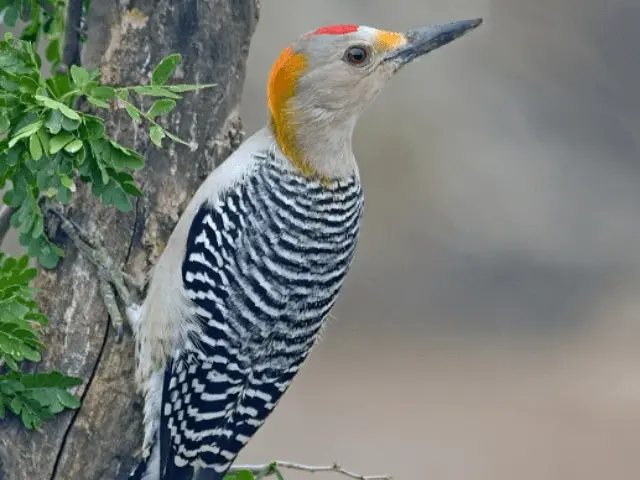
Length: 8.7 to 10.2 inches
Wingspan: 16.5 to 17.3 inches
Weight: 73 to 99 grams
Golden-fronted woodpeckers are golden visitors to Florida - pun intended - and the United States at large.
They are a gem because they’re native to Mexico with exceptional visits into the US through the southern border states of Texas and Oklahoma. Only on rare occasions do a few travel as far north into Florida.
You can tell you've made a rare sighting if you spot one with its colorful plumage. There's a bright yellow spot in front of the eyes, and blood-red from crest to the nape. The facial glow is toned with tan breasts and a black and white striped back.
Your eye would hardly miss one or a pair going about their day.
You can spot them around in an area with mesquite trees, or that's close to groves and stream woodlands. They aren't a potential tenant to Floridan bird feeders, but you can be lucky, extremely lucky.
A researcher once reported most Golden-fronted woodpeckers spotted in Florida and other eastern states were actually mutant red-bellied woodpeckers.
2. Red-Bellied Woodpecker
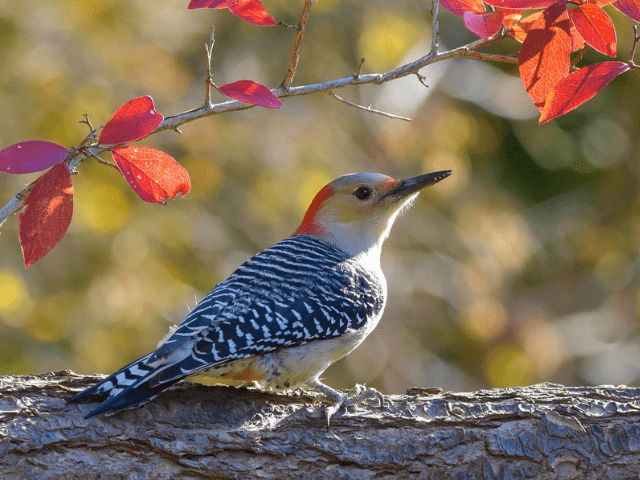
- Length: 9.4 inches
- Wingspan: 13 to 16.5 inches
- Weight: 56 to 91 grams
You don't have to go too far in Florida to spot a red-bellied woodpecker. They are among the first you'd notice in a Floridan backyard. They flourish in South Florida, and you'd almost always see them anywhere there are trees.
Red-bellies are boldly barred in black and white and a brightly-colored red mohawk. They can be hastily tagged a red-headed woodpecker because of this trait.
Most woodpeckers fly in this same pattern.
You can tell how common red-bellied woodpeckers are around once you learn their rolling call. If you stay close to wood patches, you might attract them by serving suet and peanuts.
Leave dead palm trunks or any dead trees lying around and could get them to nest in your yard.
Meanwhile, half their nests in any area are raided by invasive European starlings. If you get them to nest by mounting birdhouses, then undersize their entrance. This is one effective way how to deter starlings from invading them!
3. Downy Woodpecker
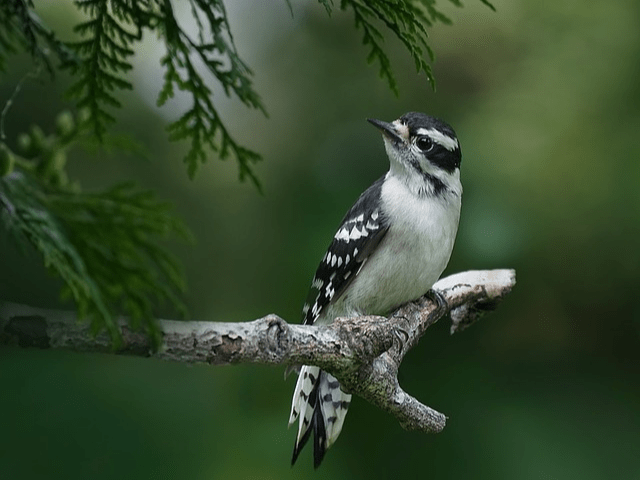
- Length: 5.5 to 6.7 inches
- Wingspan: 9.8 to 11.8 inches
- Weight: 21 to 28 grams
The downy woodpecker is minuscule for a woodpecker but exploits this to its fullest. Mostly to reach food places where the big guys can't get to, like the top of plant galls.
By the way, Downies are common year-round species in Florida. They are a distinctive stripe of black and white from beak to tail. Only adult males have a red spot at the nape of the head.
Downy woodpeckers are often mistaken for yellow-bellied sapsuckers and hair woodpeckers. With observation, it's easy to see the other birds aren't as purely colored and dwarf the Downies.
While they primarily dine on insects, they'd also be the first at a suet feeder. They even come to visit the hummingbird feeder for a sip! They are small but never below the food chain.
This feat would be impossible for larger woodpeckers who are not as acrobatic.
4. Red-Cockaded Woodpecker
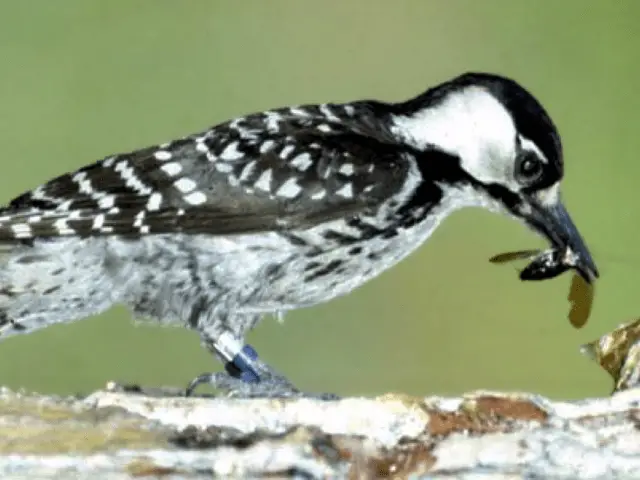
- Length: 7.9 to 9.1 inches
- Wingspan: 14.2 inches
- Weight: 42 to 52 grams
The red-cockaded woodpecker is now an endangered species from the effects of habitat loss. They nest in live pinewood trees, which happen to be wildfire magnets and clearing for timber.
They were once abundant in all 67 counties of Florida, but a legend in recent times. You only stand a good chance of seeing them in the Florida Panhandle, Apalachicola National Forest, or the Babcock/Webb Wildlife Management Area.
Red-cockaded woodpeckers don't really have red feathers that stand out. They are mostly black and white, like the hairy and downy woodpeckers. But they have distinct horizontal black and white bars over the upper wings.
You can improve their status if you happen to maintain or set aside land with pine forests. Or a mixture of matured trees ranging from 30 to 60 years old.
Like most woodpeckers, they are unique in their own way. They can hitch or walk upright on tree backs, using their tail for support. If you see any small black and white bird foraging this way, it's a red-cockaded woodpecker.
5. Hairy Woodpecker
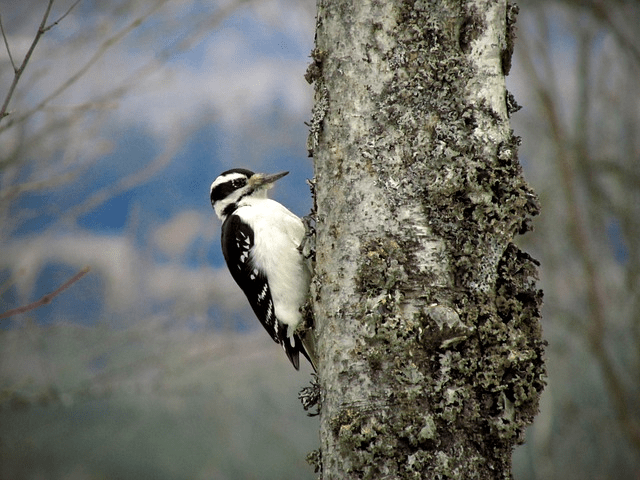
- Length: 7 to 10.2 inches
- Wingspan: 13 to 16 inches
- Weight: 40 to 95 grams
Hairy woodpeckers are lovely family birds regularly co-existing with the lookalike Downies. Sometimes, they feed off the hard work of the pileated woodpecker.
Hairy woodpeckers are large stripes of black and white, like the Downies. They have white and black striped faces, with a bright orange spot at the back of the head. A white patch stretches down the middle of the back, and the black wings checkered with white dots.
These birds also have a longer bill than the downy woodpecker's thorn-like bill. If you can tell these differences, you wouldn't mistake them as many birdwatchers do.
Plus, they are birds of many terrains, ranging from matured forests, high mountains, suburbs, parks to cemeteries. So you definitely can expect to see this woodpecker visit a backyard. Attract them with a suet feeder or serve black oil sunflower seeds.
Hairy woodpeckers would bring life to dead trees in your yard, carving out nests in barks to start a family. Later on, other cavity-nesting birds rent the holes, even flying squirrels.
FYI: There is a variety of bird food available on the market. If you like to attract these birds into your backyard, then we suggest looking for the bird seed brands you know they love to eat!
6. Pileated Woodpecker
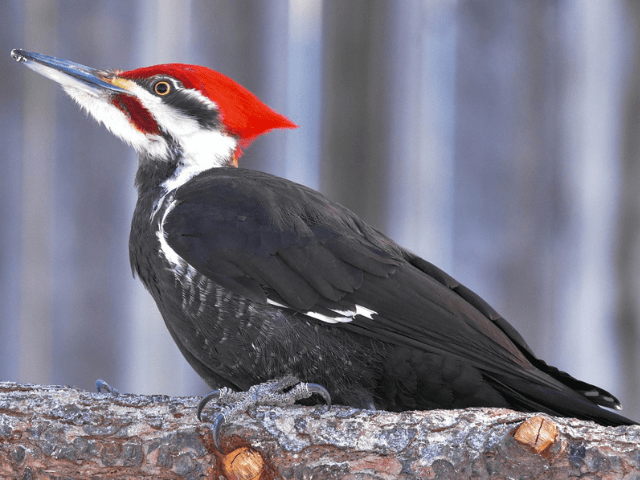
- Length: 15 to 19.3 inches
- Wingspan: 26 to 29.5 inches
- Weight: 250 to 530 grams
Pileated woodpeckers are the largest woodpecker species you may ever witness in your lifetime. And they are residents in Florida throughout the year.
Even better, the range of these breathtaking woodpecker species extends to all of Florida, except the Keys.
These crow-sized birds are hard to miss. Aside from the strong presence of their size, you can pick out their long red crest. They also display an exciting contrast of black and white when they expose their underwings.
The sound of these birds chopping at a tree for a daily meal of carpenter ants alone carries weight.
They dig large rectangular holes in dead trees or rotten wood, deep enough for small trees to break in half. However, they are a great service to humanity, too - many other bird species feed and nest in their excavations.
Pileated woodpeckers are typical forest birds but also live in partially wooded suburbs. If you have woods around your home, you may attract one to your suet feeder.
7. Yellow-Bellied Sapsucker
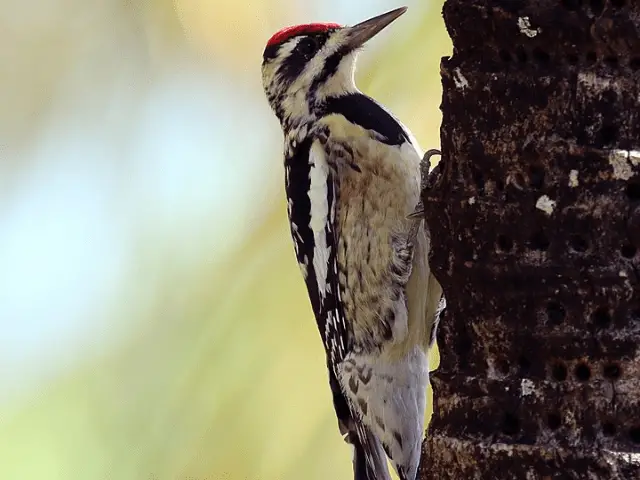
- Length: 7 to 8.7 inches
- Wingspan: 13.4 to 15.8 inches
- Weight: 43 to 55 grams
These migratory birds only come to Florida in winter, from northeastern US states. Some only pass through the state and move farther south to Texas and as far as Mexico.
The bird is one in the trio of popularly confused woodpeckers - hairy woodpecker, downy woodpecker, and the yellow-bellied sapsucker. However, the bold red stripe on one side of its head is enough to tell it apart.
Notably, only yellow-bellied sapsuckers have a white stripe down their black wings. And they do have a tinge of faded yellow on their bellies as their name implies.
Also called the vampires of woodpecker species, sapsuckers suck sap from trees and not blood. They lap up insects along with the gummy tree juice.
Yellow-bellied sapsuckers are not regulars at bird feeders. But you'd be a lucky chap if you had maple or birch trees and have them in range. These birds also come back to the same sap wells over the years, so you'd seal their presence in your backyard during winters.
8. Northern Flicker
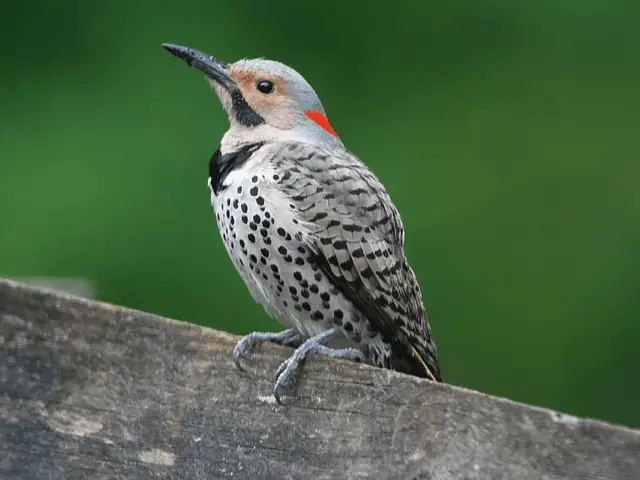
- Length: 11 to 12.2 inches
- Wingspan: 16.5 to 20.1 inches
- Weight: 110 to 160 grams
Contrary to how their name might sound, northern flickers are large woodpeckers. But also as different from most woodpeckers as their name suggests.
Unlike most woodpeckers, flickers dig up ants and insects from dirt rather than the bark of trees. While they forage on the ground primarily, a lot of their diet also comes from seeds and berries, particularly in fall and winter.
But they do drum on objects and wood for communication and territorial defense, like most woodpeckers. And dig holes to nest in tree barks, but would also take rent in an abandoned kingfisher's or bank swallow's hole sometimes.
Spotting this fairly large bird, its finely plumaged body instantly draws attention. Its brown feathers finely contrast heavy black dots and a crescent bib over the breast.
They keep a gentle and colorful impression with a brown undertone. Males have a scar-like black whisker and a red nape.
Northern flickers in eastern states like FL sport a yellow-shafted tail and flight feathers. You'll be fascinated by the flying streak of yellow when they're in flight.
Despite being common woodpeckers in the state, they don't frequent bird feeders. But they would come to your backyard if it's bird-friendly or offers a birdbath.
You'll be lucky to have a breeding pair come around if you set up nestboxes early - usually, breeding starts in April.
9. Ivory-Billed Woodpecker
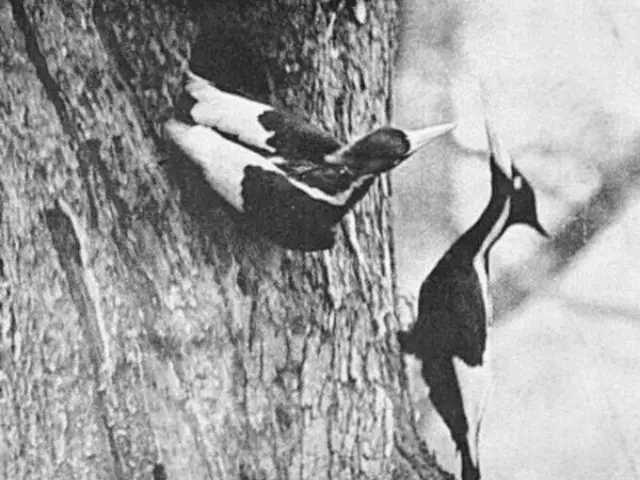
- Length: 18 to 20.1 inches
- Wingspan: 29.9 to 31.5 inches
- Weight: 450 to 570 grams
The Ivory-Billed woodpecker would be the largest woodpecker species in Florida. But the big guy has been considered an extremely rare find since the 1800s.
It has never been spotted ever since, despite many expeditions.
This majestic bird looks very much like the pileated woodpecker with its red mohawk crest, a predominantly black plumage, and heavily-built bill. Except the ivory-billed had an orange-colored bill and a visible white patch down the back of its wings.
These large birds have a distinctive "double knock" drum style. This is the easiest way to tell of their presence in the woods.
Pileated woodpeckers drill into big dead but standing trees searching for their favorite insects, larvae beetles. The plane-like wood shavings left in the wake of their excavations would give them away.
But it's safe to say you shouldn't expect to see an ivory-billed woodpecker in your backyard anytime soon. Researchers have made expeditions into their range for decades now and have come up with nothing.
Maybe you could be the lucky one that rediscovers them 😉
The video shows the controversial blurry clip of the last known sighting of an ivory-billed woodpecker in the Big Woods swamps of Arkansas.
Frequently Asked Questions (FAQs)
What Kind Of Woodpeckers Are In Florida?
There are 8 types of woodpeckers in Florida all year round with varying levels of popularity.
They include the Downy woodpecker, Red-headed woodpecker, Red-cockaded, Pileated, Red-bellied, Hairy woodpeckers, Yellow-bellied Sapsucker, and Northern Flicker.
Florida also welcomes migratory woodpecker species like Northern Flickers, Gold-Fronted woodpeckers, and Yellow-Bellied sapsuckers in winter.
What Is The Largest Woodpecker In Florida?
The Pileated woodpecker is the largest species in Florida and North America. Only the Ivory-Billed, is believed to be extinct, but the fact is skeptical.
A pileated woodpecker is about the size of a crow. It's known to break weak trees in half with its massive bill while drilling the bark for carpenter ants.
Are There Red-Headed Woodpeckers In Florida?
Yes, there are. Red-headed woodpeckers are winter residents in Florida and many other south-eastern states. They are a nearly threatened species but the half-shirt bird will survive. Perhaps they are going strong because they are the only woodpeckers that hide food away in wood or tree bark.
Wrapping Up
That's a wrap about the woodpeckers of Florida.
If you ponder attracting them to your yard, expect the cute Downies to show up early. You may even go all the way and attract pileated woodpeckers if you stay close to the woods. The red-headed woodpeckers can also brighten your day.
You can listen for the shrill call or drumming of whichever species you'd find on hiking trips. Heck, studying select pictures of the woodpeckers in Florida can be surreal.
Can you tell which of the black and white trio is on our cover photo?
It’s a hairy woodpecker. Spot the red smudge on its crest.

